by admin
Share
by admin
Share

Trigg Minerals has updated the market on its six hole drilling program which commenced on 16th September, 2024. Three of the six hole program to test new IP anomalies at SW Limey and Breccia Hill have been completed.
The SW Limey and Breccia Hill targets are located within the prolific Drummond Basin, which has been host to several large scale discoveries, cementing its status. The basin has produced over 4.5 million ounces of Gold and has a total known Gold endowment in excess of 8.49 million ounces.
Some of the notable discoveries within the Drummond Basin:
- Pajingo – 5.0 Moz
- Wirralie – 1.0 Moz
- Twin Hills – 1.0 Moz
- Yandan – 0.879koz
When including the adjacent Charters Towers province, the total epithermal endowment of past and present resources exceeds 44.1 Moz of Gold.
Some notable discoveries within the adjacent Charters Towers province are:
- Charters Towers – 21.22 Moz
- Mt Carlton 1.1 Moz
- Ravenswood 8.6 Moz
- Mt Leyshon 3 Moz
- Mt Wright 1 Moz
Epithermal System Discovery
The SW Limey prospect displayed robust chargeability and resistivity anomalies, similar to those seen at the Pajingo Gold Deposit. Historical rock chip sampling in the area revealed high-grade gold of up to 55.4 g/t Au, 34.2 g/t Au and 31 g/t Au.
The geophysical targets for the drilling campaign were identified through recent and reprocessed historical Induced Polarisation (IP) survey data.
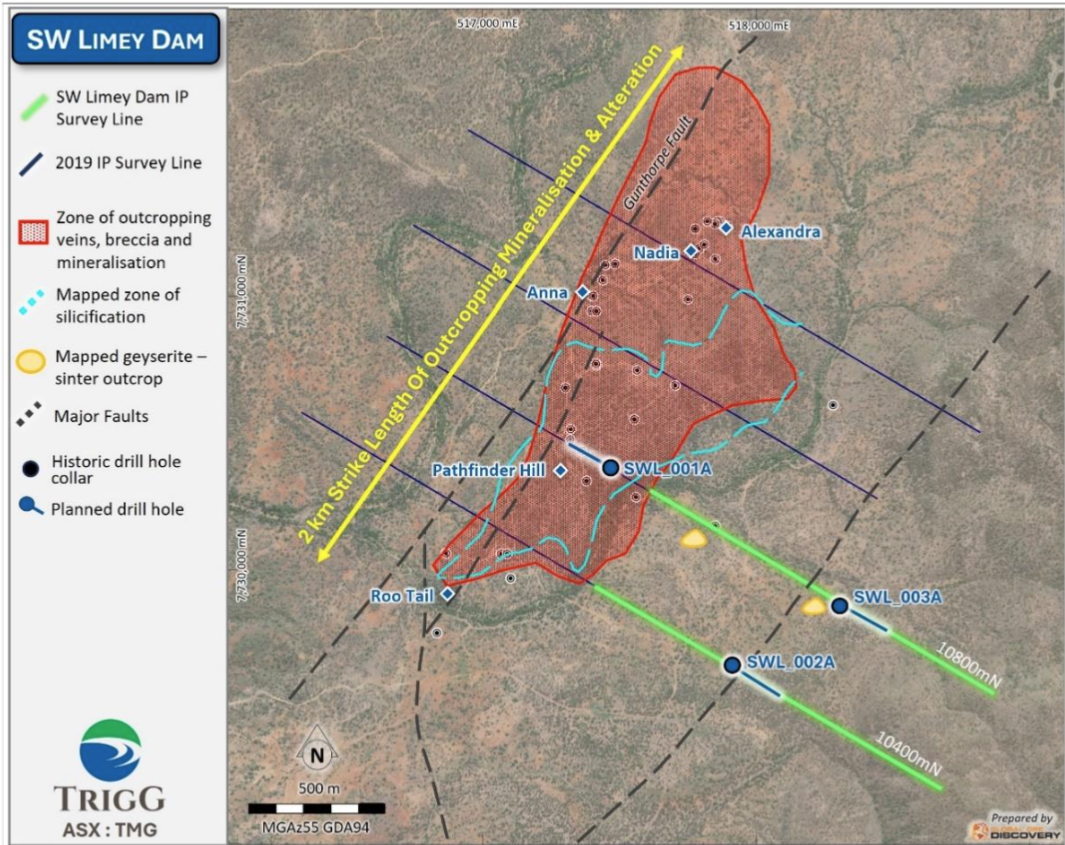
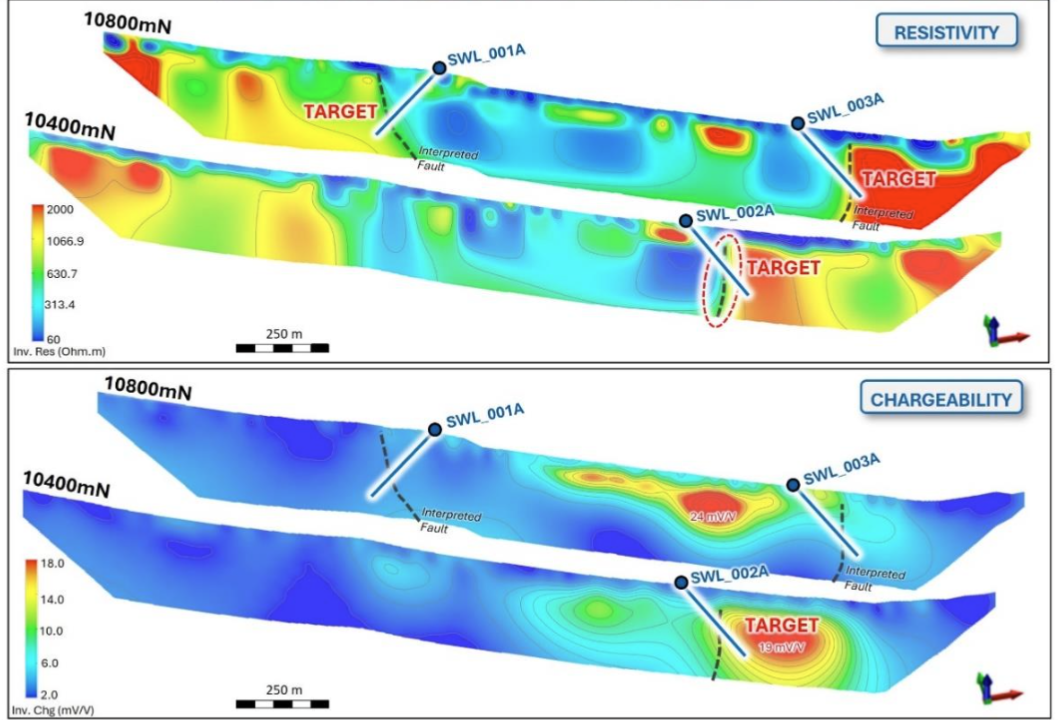
Hole LMRD001, the first of three drilled in program at SW Limey, intersected a substantial alteration zone beginning at 160 metres and extending to the end of hole (EOH) at 402 metres, with hydrothermal breccia and alteration remaining open at end of hole.
The 242-metre interval (from 160m to EOH) exhibits an increasing intensity of alteration, revealing key mineralogical and structural features that are consistent with a low-sulphidation epithermal system.
- Alteration Assemblage and Mineralogy (160m – EOH): The alteration zone primarily comprises silica-smectite and/or phengite, chlorite, and illite. This mineral suite is typical of low-sulphidation
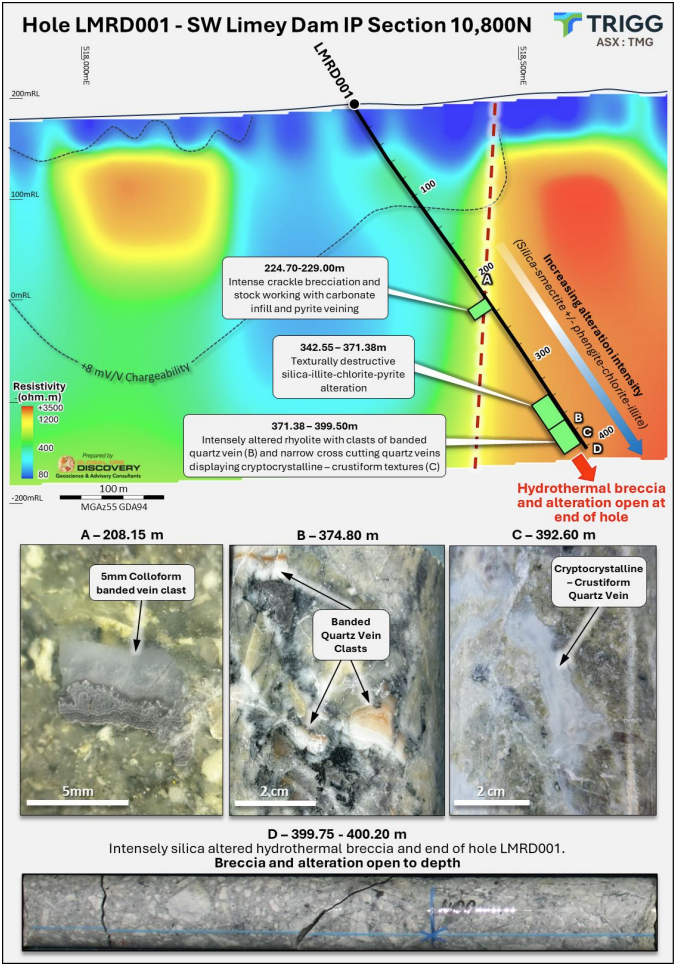 epithermal deposits, formed by hydrothermal fluids under lower temperatures and pressures, often in near-surface environments.
epithermal deposits, formed by hydrothermal fluids under lower temperatures and pressures, often in near-surface environments. - Crackle Brecciation and Stockwork (224m – 229m): A five-metre interval displays intense crackle brecciation and stockwork veining, indicative of repeated fluid flow and structural fracturing. This brecciation, characteristic of low-sulphidation environments, suggests episodes of fluid boiling or pressure fluctuations, enhancing permeability and supporting mineral deposition.
- Texturally Destructive Alteration (342.55m – 371.38m): Significant silica-illite-chlorite-pyrite alteration is observed across this 30-metre section. Texturally destructive alteration is typical in epithermal systems, where acidic hydrothermal fluids convert host rock, increasing permeability and creating pathways critical for mineralisation.
- Quartz Veining and Banded Textures (371.38m – 399.50m): Intensely altered rhyolite clasts, with evidence of banded quartz veins and narrow cross-cutting quartz veins displaying cryptocrystalline and crustiform textures, suggest a low-sulphidation setting. These vein textures result from silica deposition by low-temperature hydrothermal fluids, with banding likely reflecting rhythmic fluid flow due to boiling or pressure changes.
- Hydrothermal Breccia and Open End-of-Hole (402m): The presence of hydrothermal breccias near the end of hole, combined with persistent alteration intensity, suggests an open mineralised system at depth, indicating the potential for an extensive low-sulphidation mineralised zone.
These preliminary findings exhibit features typical of low-sulphidation epithermal systems, including silica-clay alteration, brecciation, cryptocrystalline textures, and banded and crustiform quartz veins.
Pajingo Similarities
The Drummond Basin hosts numerous low-sulphidation epithermal gold deposits, with the Pajingo (5 Moz Gold) deposit being one of the most prominent examples due to its high-grade gold and silver resources.
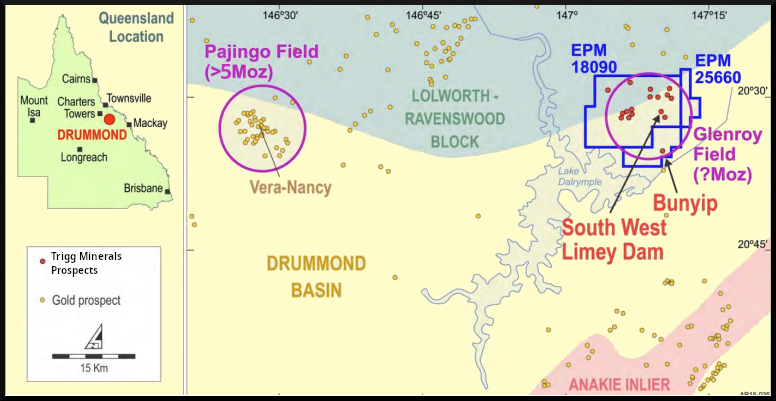
The alteration styles, mineral assemblages, and structural features observed in Hole LMRD001 show several suggestive similarities to those found at Pajingo, supporting the potential for the discovery of a comparable mineralised system:
- Silica-Clay Alteration Assemblage:
Similar to Pajingo, Hole LMRD001 displays a pervasive silica-smectite alteration with occurrences of phengite,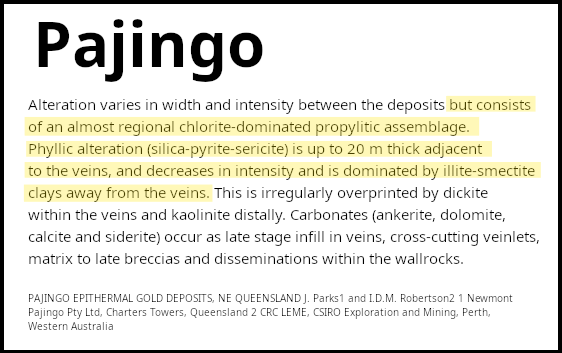 chlorite, and illite.These minerals typically form under the low-temperature, low-pressure conditions associated with low-sulphidation systems and are consistent with the alteration assemblages that characterise the Pajingo deposit.
chlorite, and illite.These minerals typically form under the low-temperature, low-pressure conditions associated with low-sulphidation systems and are consistent with the alteration assemblages that characterise the Pajingo deposit. - Crackle Brecciation and Stockwork Veining:
The crackle brecciation and stockwork textures from 224m to 229m, with carbonate and pyrite veining, are comparable to structural features in Pajingo, where multiple fluid-flow events enhanced fracture permeability and supported mineralisation. Such brecciation and stockwork patterns are indicative of episodic boiling and pressure fluctuations; processes known to play a critical role in concentrating gold in low-sulphidation epithermal systems like Pajingo. - Texturally Destructive Alteration:
Textural destruction by silica-illite-chlorite-pyrite alteration over a significant interval (342.55m to 371.38m) is also a notable similarity to Pajingo. In Pajingo, destructive silica and clay alteration has been a key feature, creating porous zones and pathways for mineralising fluids. This process aligns with observations in LMRD001, where acidic hydrothermal fluids may have similarly altered the host rock, potentially creating optimal conditions for precious metal deposition. - Banded and Crustiform Quartz Veining:
The occurrence of banded quartz veins with cryptocrystalline and crustiform textures (371.38m to 399.50m) is a hallmark of low-sulphidation epithermal systems and is also characteristic of Pajingo. Crustiform texture is so commonly associated with epithermal veins, that it can be considered a diagnostic feature. These rhythmic and layered vein textures reflect repeated hydrothermal pulses and boiling events, which can enhance gold deposition. The presence of crustiform textures in Hole LMRD001 potentially mirror the banded quartz veining seen at Pajingo and suggests similar mineralising processes may be at work.
Next Steps
The company expects the assays to be available Q4 CY 2024.
Disclaimer: Bullseye Analytics (the company) or associated entities own 150,000,000 TMGOD options as of the publication date of this article.

